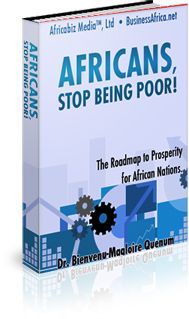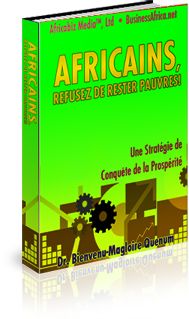|
****JavaScript based drop down DHTML menu generated by NavStudio. (OpenCube Inc. - http://www.opencube.com)****



|
| ! |
| AFRICABIZ
VOL 1 - ISSUE: 63
JULY
15 - AUGUST 14, 2004
Previous
Issue
Editor: Dr. Bienvenu-Magloire Quenum
editor@africabiz.org
| |
A
WORD FROM THE EDITOR
| | |
|
Dear visitor and international investor,
We
warmly welcome you, if this is
your first visit to Africabiz
Online - The ultimate newsletter
on trading and investing in 49
sub-Saharan African countries.
If you are a regular and faithful
reader, welcome back.
-
HELP US KEEP FREE ACCESS TO AFRICABIZ
ONLINE
Since May 1999, Africabiz Online's editorial staff endeavors providing you with
high quality content in business opportunities and computer management and productivity.
All this done without compulsory registration or any payment to access our websites.
Yet, we do have recurrent operating expenses. Nevertheless, we decide to keep
- for the time - free access to all pages of Africabiz and compensate with Advertisement.
To
help us keep free access, please do click on our advertisers' banners, button
and links when reading valuable content on Africabiz Online pages.
You
will help us earn some bucks to pay for server side's expenses. You may help yourself
too visiting the websites links to banners, buttons and links. Who knows. The
net is full of astounding surprises and opportunities for the one who is curious.
You could
certainly use an extra $300 to $1,000 a month? Sure you could. You certainly
also want to know how
to to secure your dream home or first investment in real estate. Right?
-
SHOULD AFRICAN COUNTRIES REFUSE TO
PAY BACK DEBTS?
The
debt load supported by sub-Saharan African countries is, since three decades,
one of the most debated and hot item on the agenda of international meetings of
head of states, non-governmental organizations and conferences about developing.
In spite of several initiatives, particularly the Highly Indebted Poor Countries
(HIPC) resolution taken in 1996 by the IMF and the World Bank, the problem is
still unresolved eight years latter in 2004. African countries are still paying
back more money to international creditors and having less financial resources
to plan for the developing. Indeed:
-
Between 1990 and 1993 the government of Zambia spent $37 million on primary school
education. Over the same period, it spent $1.3 billion on debt repayments. Repayments
to the IMF alone were equivalent to ten times government spending on primary education.
-
External debt per capita for sub-Saharan Africa (not including South Africa) is
$365, while GNP per capita is just $308.
- The external debt for the region
(again excluding South Africa), at some $203 billion in 1996, represents 313%
of the annual value of its exports.
- Debt servicing for sub-Saharan Africa
amounts to about 20% of its annual export income -- that is, everything the region
earns from those goods it is able to sell for hard currency (dollars, marks, yen,
etc.). Source: 50
Years is enough |
Thus, many opinion-leaders are voicing for the cancellation of the debt. Some
are increasingly impatient the leaders of the G-7 / G-8 are not tackling the problem
to finding a solution to alleviate the burden from African countries shoulders.
Pr. Jeffrey Sachs, director of the Earth Institute at Columbia University
and United Nations Secretary General' special adviser on global anti-poverty targets
declared, on July 4, 2004, at the Hunger Conference at Addis Ababa, Ethiopia:
"The time has come to end this charade. The debts are unaffordable If they
won't cancel the debts I would suggest obstruction; you do it yourselves."
This is the first time a prominent figure advised for such a radical action.
Till now only non governmental organizations were voicing such move. Some
of them speaking of Odious Debt.
Could African countries afford following
that advise? Would they be better off taking such a radical move? Could the brutal
cancellation of debts boost the economic development of African countries to creating
riches for all and alleviating rampant poverty? Click
here to read about: Debt Payment Reorientation as Equity Shares in Developing
Projects. -
Contributor's Guidelines
are here to review. Your contribution on "How African countries
/ entrepreneurs could bridge the developing gap" is welcome.
Many thanks for dropping by and see you here on August 15, 2004.
Dr. B.M. Quenum
Editor
of AFRICABIZ
 | | |
|
|
BUSINESS
OPPORTUNITIES IN AFRICA
| |
-
Several business opportunities - component parts of the Integrated Developing Scheme described in Africans, Stop Being Poor! are listed in following table.
| a-
SHEA BUTTER ( 5,
6, 7,
11, 12,
13)
b- BLUE GOLD ( 14,
15, 16,
17, 18,
19)
c- FREEZE-DRIED PAPAIN ( 20,
21, 22
and here)
d-
KENAF ( 23,
24)
e- VEGETABLE OIL ( 25,
26, 27,
28)
f- CEREALS ( 30,
31, 32,
33)
g- FRUITS (34,
35, 36,
37, 38,
39, 40,
42, 43,
44, 45,
46)
h- ESSENTIAL OILS (47,
48, 49,
50, 51,
52)
i- ROOTS & TUBERS 54,
55, 56,
57, 58,
59, 60,
61, 62)
| -
TROPICAL ROOTS AND TUBERS: (VII) - D-
INVESTMENT AND OPERATING BRIEFS ABOUT A MEDIUM-SCALE GARI PROCESSING PLANT
Cassava, potato, and
sweet potato rank
among the top 10 food crops produced in developing countries. Sub-Saharan
Africa - SSA - is expected to experience the fastest growth in food demand
for all roots and tubers, largely driven by rapid population's growth. SSA
share in the total demand for developing countries will be 53 percent, with cassava
accounting for two-thirds of the increase.
Here are listed four processed cassava's products, which highlight the fact
that cassava could be an important components - an Economic Catalyst -
to the Integrated Economic
Development Scheme. Briefs on the preparation of fresh cassava prior to the
production of chips and pellets are
reported here. Operating conditions to producing
cassava ships on a small-scale basis are posted here.
The following
link dealt with Investment
briefs to producing cassava floor with small-scale industrial units. Each
unit can create 60 jobs or 60,000 jobs if 1,000 units are installed. That is a
lot for rural areas in a developing country.
Starting from Issue
60, four deliveries (A - Introduction
B- Market
C - Plantation's
creation and D - Medium-scale industrial production unit) deal with the
production of a granulated cassava flour that is a popular food in Africa: GARI
Basic
data to creating and running a cassava plantation to supply fresh cassava to the
medium-scale gari processing plant are
here reported
-
C- PROCESSING PLANT OPERATING CONDITIONS
The
medium-scale processing plant is tailored to transform 10,000 metric tons of fresh
cassava per year - at full capacity and at following operating conditions: a)
One shift, 8 hours; b) 22 days per month and c) Processing of 38 metric tons of
fresh cassava per day using cassava variety TMS 81/ 00110 (see table above) that
produces 28 metric tons of fresh cassava per hectare (in optimal cultivation conditions).
| PERSONNEL | -
One Manager
- One Accountant
- One Production / Technical manager
-
Two mechanics
- Two lorries drivers
- 100 people for peeling
- 10 handling
persons
- 5 Persons in charge of processing
- 5 Persons in charge of packaging. | | PROCESSING
CHARACTERISTICS | -
Hand peeling.
- Two light handling equipment
- Modular equipment working
in continuous process from pressing of grated cassava roots to the sifting and
packing of the final product.
- Water consumption 19 cubic meters per day.
Necessity to install a purification system to reuse water.
- Autonomous
power generation system (9 KVA) powered by bio-gas generated by a wastes' digester
device that uses peeling wastes.
- Drying process using bottled butane gas
to avoid environmental forest degradation resulting from the use of wood. (Average
consumption of butane gas equal to 80 gr. to obtaining 1 kg of Gari)
- Packaging
system for 20, 20 kg and 50 kg bags |
-
C - INVESTMENT ESTIMATE TO PRODUCING ONE METRIC TON OF
GARI
Staffing
and main characteristic of the processing plant are reported in Table above are
used to estimate operating costs to producing one metric ton of Gari - reported
in Table below. Electrical consumption is around 1,400 kWh per day. You may,
using these briefs information, calculate salaries and ancillaries operating costs
in your country. Dr. Quenum & Associates
are available for detailed Business Plan in
accordance with tentative terms of reference here outlined in another Business
opportunity example.
| | Amount
(US$ x 1,000) | |
INVESTMENT
| |
1- Processing Equipment: Know How acquisition - Equipment
purchase and setup - Blank Startup Assistance (for three months) - Spare Parts
- Etc. |
420 |
| 2-
Starting expenses: Feasibility study / Business Plan
for the processing plant - startup technical assistance (for six months) Etc.
Click
here for tentative terms of references covering
production and investment planning by Dr. Quenum & Associates.
| 55 |
| Total
investment | 475 |
| FULL
CAPACITY YEARLY PRODUCTION |
| Coarse
Gari Flour = 38 metric tons of raw material per day x 22
days per month x 12 months x 24 % gari's yield = 2,407 metric tons of gari per
year | |
OPERATING COSTS
| | Operational
Expenses: Raw material
cost - production costs: insurance - utilities - staff and hands - management
salaries - packaging - external management assistance - amortization - interests
on loan. Etc. |
409 |
| PRODUCTION
COST PER METRIC TON EX-WORKS |
| 409,000/
2,407 | 170 |
| GENERATED
GROSS REVENUES | | Considering
5% profit margin over production cost | 430 |
Production cost
par metric ton is below US 180 as here
reported. It could be significantly lowered by efficient management of the
processing or the setup of two production' shifts to increase the output. As per
information and data provided in
Issue 61, there is the possibility to establish in Africa 8,000 operations
similar to the one hereby described to creating around 1,096,000 industrial
jobs in rural areas.
Adobe
Acrobat Reader is available here
- Interested parties - private African and international investors /
companies, government
agencies,
international development
agencies - to make contact through the Free Access Support Console available at this link
Contact through the support console will get quickest reply from Africabiz Online's staff, than contact by emails. Click here for contact information. Be advised that first contact should be through the support console to be followed by phone calls. If you are a VIP-Member, use VIP-Members Support Console available here.
Before you consult please click
here to review this clarification |
|

